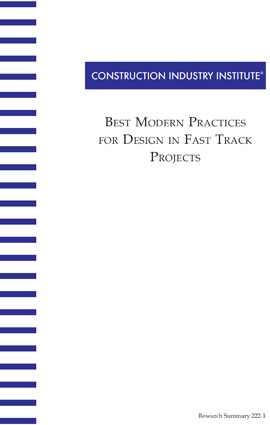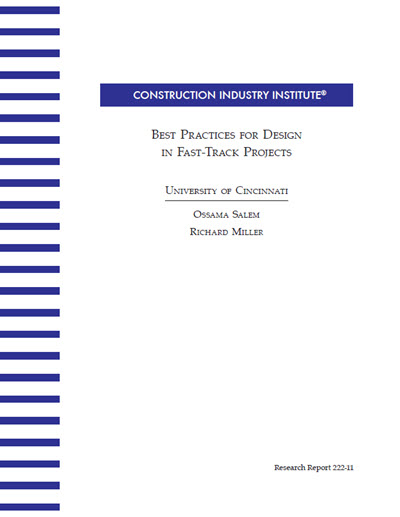
Best Modern Practices for Design in Fast Track Projects
Fast track design-build projects significantly overlap the design phase with the procurement and construction phases. In a fast track project, design becomes the prime mover of project progress because the performance of procurement and construction processes depends on availability of timely and accurate information from the design process.
CII formed the Best Modern Practices for Design in Fast Track Research Team to study this facet of construction. The main objective was to identify best practices that have an impact on the performance of the design phase in fast track projects. Secondary objectives included the identification of correlations between use of CII Best Practices and performance of the design phase in fast track projects, challenges faced in managing the design of fast track projects, and solutions used to mitigate these challenges.
The results indicate that those best practices identified by the research as being most influential to successful management of design (front end planning, change management, constructability, alignment) were also found to have statistically significant positive correlation with the schedule performance of design in fast track projects. The most commonly faced challenges in managing design in fast track projects were identified as:
- Lack of adequate front end planning
- Inadequate alignment within and across organizations working together in projects.
- Scope creep resulting in changes
- Getting timely and accurate information from vendors
- Coordination and teamwork within the design team and between organizations.
- Limited availability of skilled and experienced design work force.
RT-222 identified the six most commonly faced challenges in managing design in fast track projects:
- Lack of adequate front end planning
- Inadequate alignment within and across organizations working together in projects
- Scope creep resulting in changes
- Getting timely and accurate information from suppliers
- Coordination and teamwork within the design team and between organizations
- Limited availability of skilled and experienced design work force
The schedule and cost performance of the design phase as well as overall project performance are all impacted by external factors, which include project complexity, regulatory requirements, project team turnover, project team performance, offshore engineering, funding/finance, and others.
The team’s research details solutions to mitigate these challenges (RS222-1, p. v).
Project team experience and turnover have a significant impact on schedule, quality, and accuracy of the design effort. The loss of key engineering personnel adversely affects the design cost and schedule. The table below shows the impact of project team experience and turnover in the fast track projects.
This study revealed that adequate skills were not available within the organizations surveyed that execute design in fast track projects. Solutions to improve project team experience and turnover are provided in the research findings. For example, one solution is to develop a network of trusted design subcontractors and make use of the skill sets available with them.
Improvement in design schedule performance in fast track projects is related to the extent of implementation of CII Best Practices of front end planning, change management, constructability, and alignment. This research indicates that adequate front end planning (FEP) is one of the most critical best practices for the success of design in fast track projects and that more time being allocated for FEP is beneficial. (RS222-1, p. 10)


